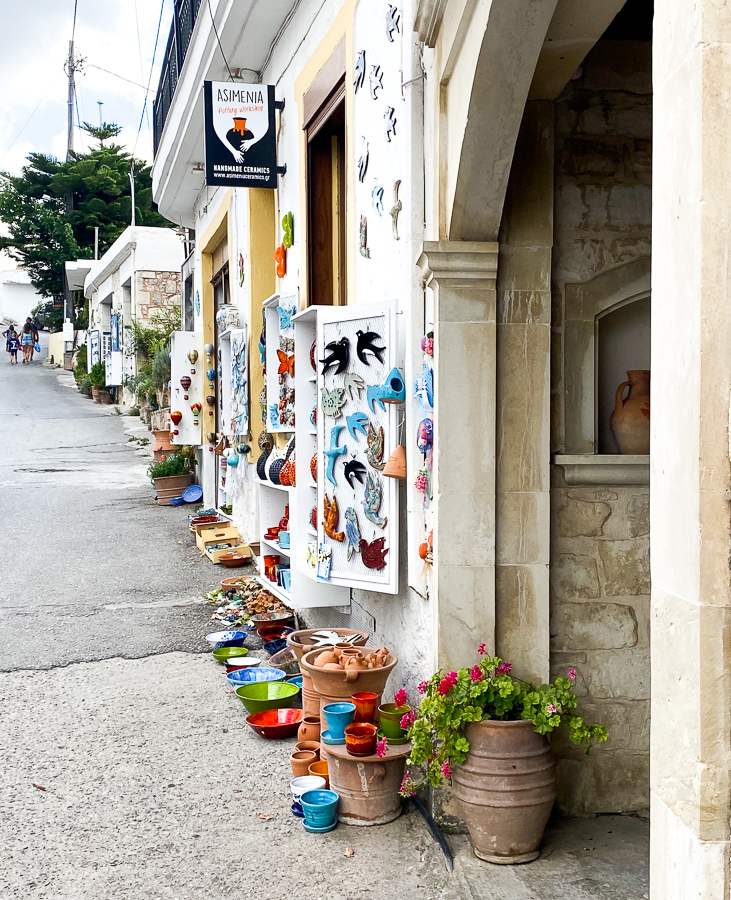Crete, the largest of the Greek islands, boasts a rich cultural heritage that is deeply intertwined with the art of pottery. From the Minoan civilization to contemporary artisans, Cretan pottery has evolved over millennia, reflecting the island’s history, traditions, and natural beauty. This guide delves into the fascinating world of Cretan pottery, exploring its historical significance, the techniques employed by local potters, and where you can experience this enduring craft firsthand.
A Historical Overview
The roots of Cretan pottery stretch back to the Minoan civilization, which flourished around 2000 BCE. The Minoans were renowned for their sophisticated pottery, characterized by intricate designs and vibrant colors. These early works often depicted marine life, plants, and religious motifs, showcasing the Minoans’ connection to nature and spirituality. The famous Kamares ware, with its dark background and contrasting light patterns, exemplifies the artistic excellence of this era.
Following the Minoan period, Cretan pottery continued to evolve under the influence of various cultures, including the Mycenaeans, Romans, Byzantines, Venetians, and Ottomans. Each of these periods left its mark on Cretan pottery, contributing to a diverse and rich artistic tradition that persists to this day.
Techniques and Materials
Cretan potters use a variety of techniques and materials to create their distinctive works. The island’s abundant natural resources, such as high-quality clay and mineral pigments, provide the foundation for their artistry.
Clay Preparation: The process begins with sourcing and preparing the clay. Local potters often use clay from specific regions known for their fine quality. The clay is then mixed with water and kneaded to achieve the desired consistency.
Wheel Throwing and Hand Building: Traditional wheel throwing is a common technique used by Cretan potters. This method involves shaping the clay on a rotating wheel, allowing for the creation of symmetrical and precise forms. Hand-building techniques, such as coiling and slab construction, are also employed to craft more complex and unique shapes.
Decoration and Glazing: Once the basic form is created, the potters decorate their pieces using various techniques. These include incising patterns into the clay, applying slip (a liquid clay mixture), and painting with natural mineral pigments. Glazing adds a protective and decorative finish, enhancing the piece’s durability and aesthetic appeal.
Firing: The final step is firing the pottery in a kiln. Traditional wood-fired kilns, as well as modern electric and gas kilns, are used to achieve the high temperatures needed to harden the clay and set the glaze. This process often requires careful control and expertise to ensure the pieces emerge strong and beautifully finished.
Styles and Motifs
Cretan pottery is known for its distinctive styles and motifs, which reflect the island’s cultural heritage and natural environment.
Minoan Influence: The influence of Minoan pottery is still evident in contemporary works. Spirals, marine life, and floral patterns are common motifs, echoing the ancient designs that once adorned palaces and temples.
Geometric Patterns: Geometric patterns, including meanders, triangles, and checkerboards, are a staple of Cretan pottery. These designs often have symbolic meanings and add a rhythmic visual appeal to the pieces.
Nature Themes: Inspired by the island’s rich biodiversity, many Cretan potters incorporate themes from nature into their work. Olive branches, grapevines, and animals frequently appear in their designs, celebrating the island’s flora and fauna.
Visiting Cretan Pottery Studios
Exploring Cretan pottery firsthand offers a unique glimpse into this ancient art form. Many pottery studios across the island welcome visitors, providing the opportunity to watch artisans at work and even try your hand at pottery.
Thrapsano: Known as the pottery village of Crete, Thrapsano is a must-visit destination for pottery enthusiasts. The village is home to numerous family-run workshops where traditional techniques have been passed down through generations. Visitors can observe the potters as they craft their pieces and purchase unique, handmade items directly from the artisans.
Margarites: Located in the Rethymnon region, Margarites is another renowned pottery village. The narrow streets are lined with studios and shops, offering a wide range of pottery styles. The village’s picturesque setting and rich pottery heritage make it a popular destination for those looking to explore Cretan craftsmanship.
Heraklion: The capital city of Crete also boasts several pottery studios and galleries. Here, you can find both traditional and contemporary pieces, reflecting the dynamic evolution of Cretan pottery. Workshops and demonstrations are often available, providing a hands-on experience for visitors.
Collecting and Appreciating Cretan Pottery
Collecting Cretan pottery is not only a way to support local artisans but also to bring a piece of the island’s cultural heritage into your home. When selecting pieces, consider the craftsmanship, design, and the story behind each item. Authentic Cretan pottery often bears the signature or mark of the artisan, ensuring its origin and quality.
Caring for your pottery involves simple steps to preserve its beauty and integrity. Hand washing is recommended for most pieces, and avoiding extreme temperature changes will prevent cracking or damage.
Conclusion
Cretan pottery is a testament to the island’s enduring artistic traditions and the skill of its artisans. From its ancient roots to contemporary innovations, Cretan pottery continues to captivate with its beauty, craftsmanship, and cultural significance. Whether you are a collector, a curious traveler, or an art enthusiast, exploring the world of Cretan pottery offers a deeper appreciation for this timeless craft. Visit the studios, meet the artisans, and immerse yourself in the rich heritage of Cretan pottery, where every piece tells a story of the island’s history and artistry.


